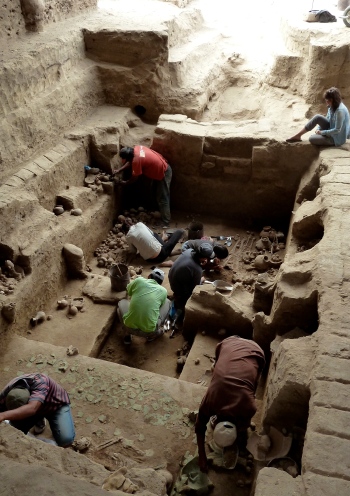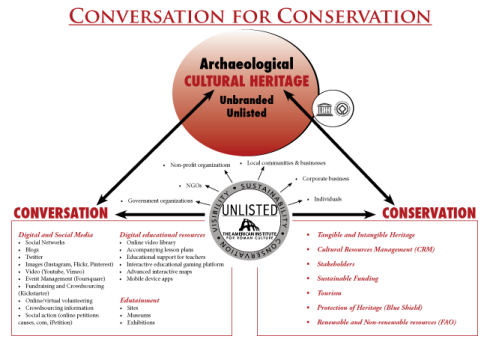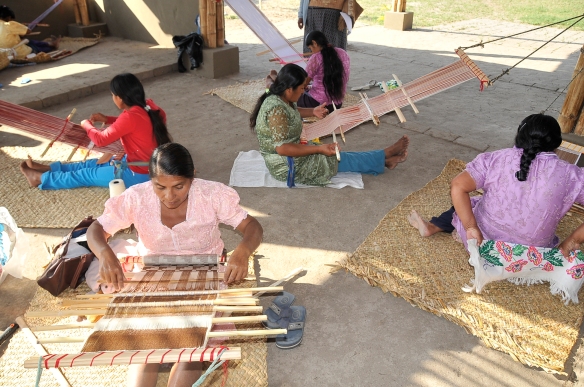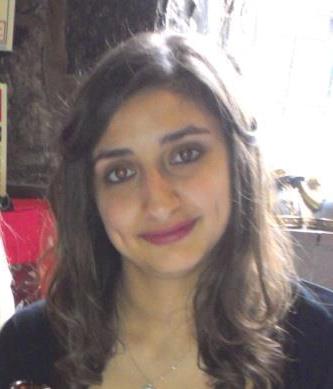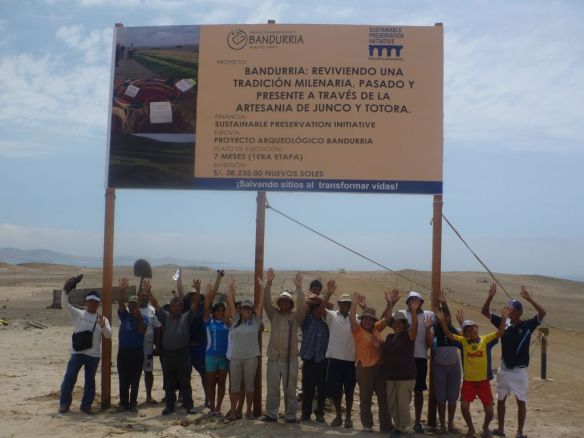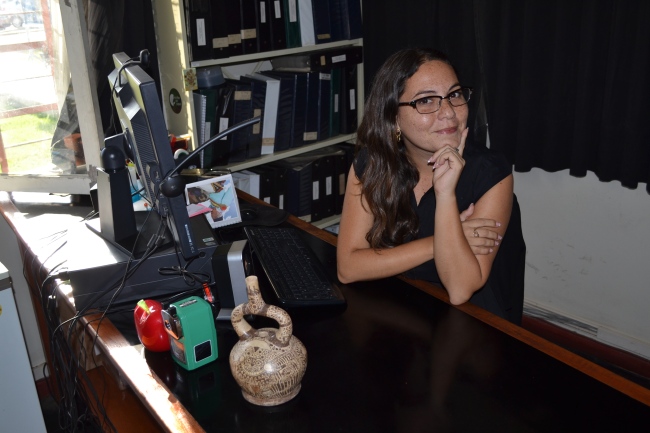By Alex Parody, Sarah Martini and Solsiré Cusicanqui
For the past three years, the Sustainable Preservation Initiative (SPI) has partnered with the San José de Moro Archaeological Program (PASJM), among others around the world, to help connect and involve communities in their local archaeological projects. These community projects benefit both the archaeologists and the local populations by encouraging interaction and discourse between groups that are often set at odds.
During the summer months of June, July and August, the San José de Moro Archaeological Program (PASJM) brings students, professors, and researchers from all over the world together to learn about archaeological investigation in Peru. The site employs local workers to aid archaeologists and students with uncovering the prehistoric artifacts, architecture, and tombs.This year over 25 student volunteers from PASJM, including Alex Parody and Sarah Martini, had the opportunity to observe and participate in an SPI-directed program.
A Peruvian Perspective
My name is Alex Parody and I am an undergraduate studying history and anthropology at American University in Washington, D.C. I have had no previous experience in archaeology but have always had a deep interest in the past. This trip was my first foray into the field, and I have loved every aspect of it. Because my mother is Peruvian I had the opportunity to travel to Peru twice before, but this trip has by far been the best. Although I grew up knowing Peruvian cuisine and customs, during the last five weeks I have come to appreciate the sheer kindness and welcoming attitudes of the people of San José de Moro, not to mention their terrific local cooking! They were always open to conversation and loved talking about their town, culture, and listening to what you had to say. Because of this, as well as being able to speak Spanish, I felt very connected to the workers at the site. I know that I am going to miss every single one of them like they were my best friend. They essentially “raised” the archaeologist in me – having taught me how to do everything from basic tasks like brushing and digging to measuring, surveying and identifying features in soils. They even helped me learn how to differentiate one kind of soil from another. I loved seeing every side of this town during the past five weeks, and because of this trip I am more confident than ever that I want to get involved in archaeology.
A New Experience
Hi! My name is Sarah Martini and I am a second year undergraduate concentrating in archaeology at Harvard University. Moro was my first chance to both come to South America and to see what being a field archaeologist entails. Having only traveled in European countries before, Peru was a completely new experience. While things were not always as I expected them to be, over the last five weeks I have fallen in love with the many faces of the Peruvian countryside, the Peruvian cuisine (I love Lomo Saltado!), and the local communities that opened up their homes to us. The people here were certainly more welcoming than many others that I have encountered in previous travels. Although I came to Peru having only taken a semester of Spanish, I found that my speaking skills quickly improved through attempting to maintain conversations with workmen from the town as I enjoyed learning about their home country from them. Over all, my experience at Moro has made me want to become an archaeologist, one involved with local communities, even more than before and has made me want to return to Peru.
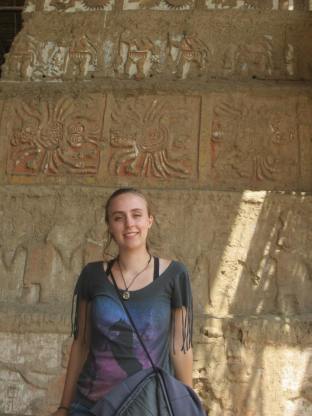
Sarah Martini, Second Year Archaeology Undergraduate at Harvard University
The Field
The archaeology at San José de Moro provides a hands-on approach for any field school student. Conditions in the field could sometimes be hard under the hot Peruvian sun, since every day was different, it made every moment exciting as you never knew what could happen next. The great thing about Moro is that it teaches students the basics of archaeology; skills that we could take anywhere is the world. But we would say that best of all were the valuable opportunities to excavate rich tombs – which for most archaeologists are only the stuff of dreams. In addition, Moro facilitates daily interactions with the locals through the opening of their homes for home-cooked meals. The women who cooked were very friendly and sometimes had their children bring out food for us. We got to know the women’s personalities (and cooking!) in this way. Because the site is right inside the community, it was very common for people to walk by the excavation units, and people always liked to look at what we were doing and often stopped to talk with us. There were plenty of times in the field when the local children came into the pits and helped (with permission of course) excavate features with us. There were endless opportunities for us to interact with the community, and the community loved to interact with us!
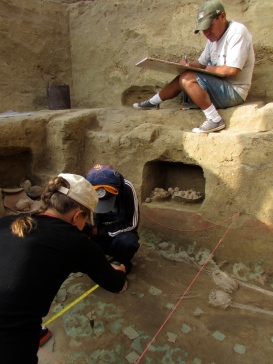
A Mural Competition
This year, SPI contributed to community-field school interactions through a mural design competition at the local elementary school. In collaboration with the children we created some fantastic artwork. The children were very welcoming and loved to draw! It was fun to compare favorite games, movies and music. It was also interesting to see the depth of knowledge and pride the children had in their cultural heritage as descendants of the Moche. They seemed to love having us there, and we hope that in the end we helped to encourage them to follow their dreams. Working with them made us both want to get more involved with community projects – in Peru and elsewhere – and also offered us the clearest view of the types of influences the children of San José de Moro come into contact with as they grow up. From movies to music to games, they are not much different from the children back home! It is interesting to see, however, how important their local history is to them. On the 28th of July, Peru’s Independence Day, some children put on a small show celebrating their country’s rich history, and others orated poems expressing love for their town of San José de Moro – from its vivid history and culture to its modern people and cuisine, there was nothing they couldn’t love more about their home!
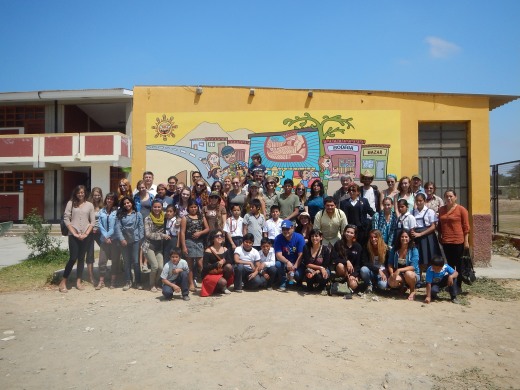
SPI Projects on the Northern Coast
Moro has another SPI-initiated project, where local ceramicist Julio Ibarrola produces replicas of Moche and Lambayeque pottery that have been found at the site itself. He is currently apprenticing a few local teenagers and in this way hopes to continue the tradition of ceramic reproduction, as well as create a sustainable economy for the town. His replicas are found not only in Moro but also in the gift shops of museums all around Peru and through an online vendor, he gives his industry the potential to be a great source of income for those who become involved.
Before reaching Moro, we visited another SPI site which was the Chotuna and Chornancap Archaeological Complex. While this site has been recently made famous for its priestess burial found last year, the SPI has brought local women back in touch with their cultural roots through a weaving program. It allows the community to connect with the archaeological site, provides potential revenue through sales at the gift shop, and provides the opportunity to learn about traditional methods of cloth production. During the last week of the field school, we had the opportunity to work with Moro´s weavers, who have also become involved with the help of SPI. The women were happy to answer any questions we had about the weaving process when they came to the field school at Moro. They even allowed students to try their hand at setting up a back-strap loom. All of the students tried, but the women were much faster than any of us! Even so, they were very patient in explaining the process numerous times to the different students.
It is an unfortunate truth that throughout history many archaeologists have not involved themselves with local communities, maintaining a distance between their familiar group of colleagues and the residents who live among the site. Even when they have made an effort to improve the economy of the community, such as building a museum, many projects have focused on increasing tourism without encouraging local involvement in the site. This tourism fails to help communities when gift shops lack locally-made artisan goods – it is important to include local artisan crafts (such as Julio’s ceramics or the weavers’ textiles) because without them, the money spent at the museum by tourists does not always stay with the community. This idea would not get far if interactions between archaeologists and locals are hampered by an invisible wall created by many differences ranging from socioeconomic to cultural, as well as by the absence of some great impetus for interaction. Part of SPI’s mission is to provide that impetus. Its efforts to increase local involvement in archaeological projects, by allowing locals to learn about their cultural heritage and how it can be preserved, are the first steps in bridging the gap between archaeologists and the local communities in which they work.
